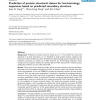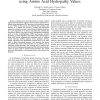262 search results - page 4 / 53 » Protein secondary structure prediction using neural networks |
BMCBI
2006
13 years 9 months ago
2006
Background: One-dimensional protein structures such as secondary structures or contact numbers are useful for three-dimensional structure prediction and helpful for intuitive unde...
CIBCB
2009
IEEE
13 years 10 months ago
2009
IEEE
Tools for the identification of trans-membrane spans from the protein sequence are widely used in the experimental community. Computational structural biology seeks to increase the...
BMCBI
2010
13 years 9 months ago
2010
Background: Prediction of protein structural classes (a, b, a + b and a/b) from amino acid sequences is of great importance, as it is beneficial to study protein function, regulat...
CIBCB
2005
IEEE
14 years 2 months ago
2005
IEEE
— Proteins have been discovered to contain ordered regions and disordered regions, where ordered regions have a defined three-dimensional (3D) structure and disordered regions d...
BMCBI
2008
13 years 9 months ago
2008
Background: Since experimental determination of protein folding pathways remains difficult, computational techniques are often used to simulate protein folding. Most current techn...



